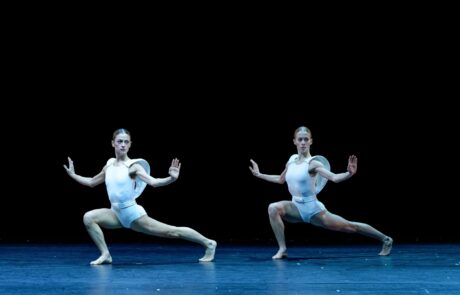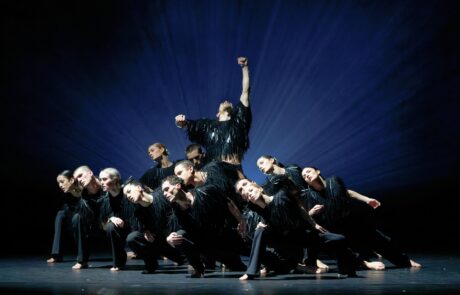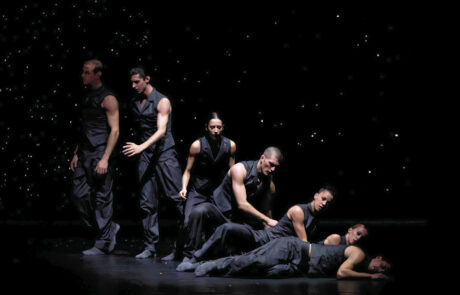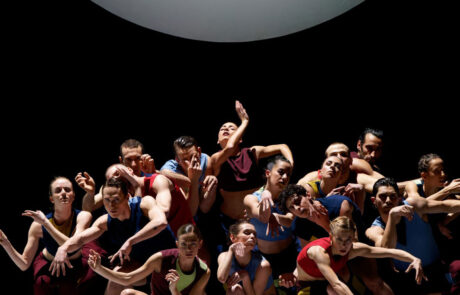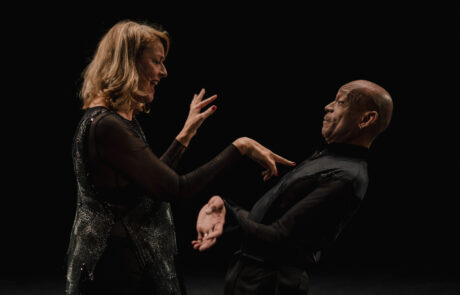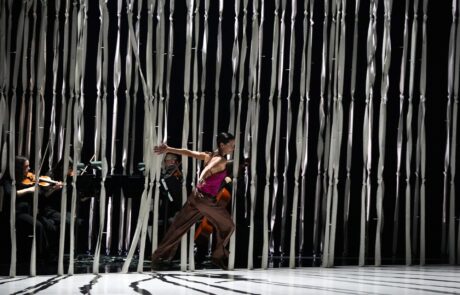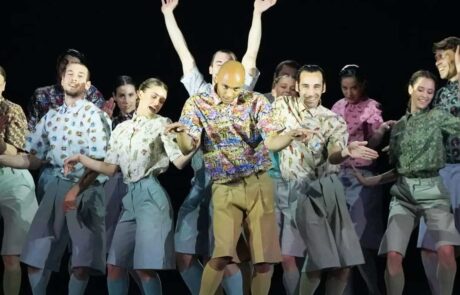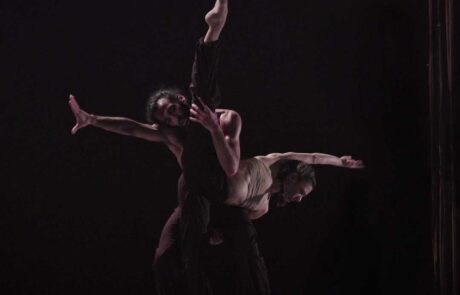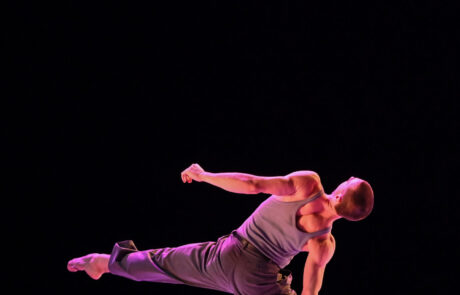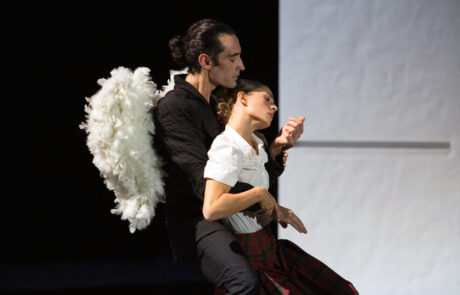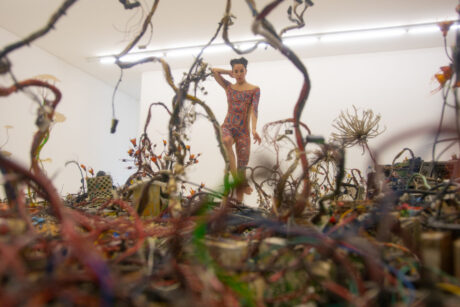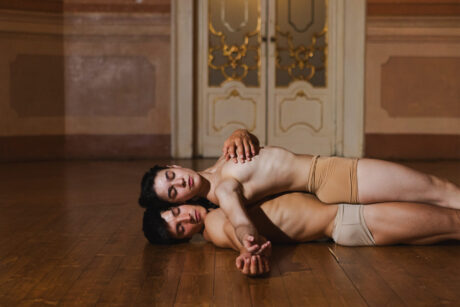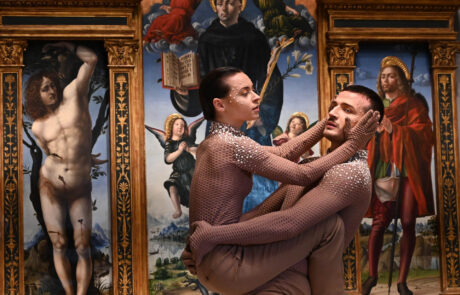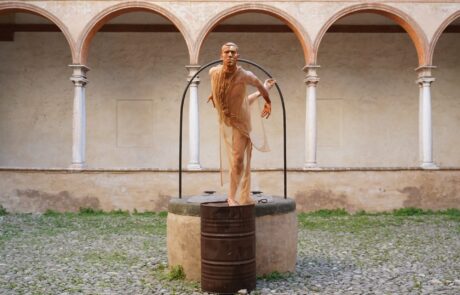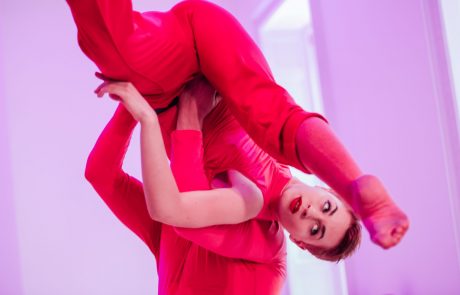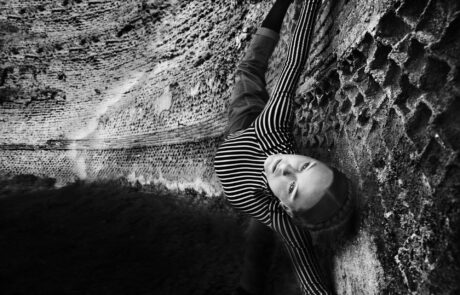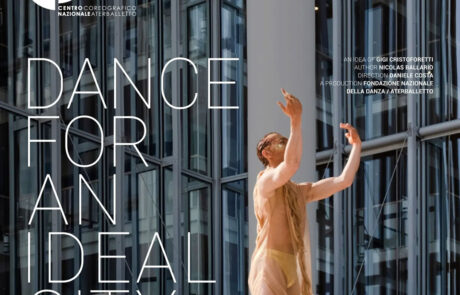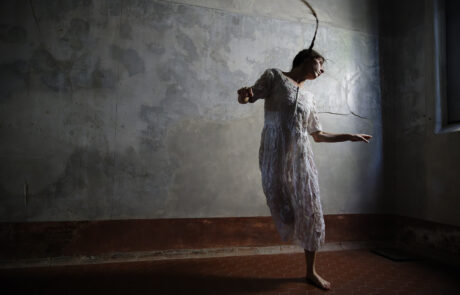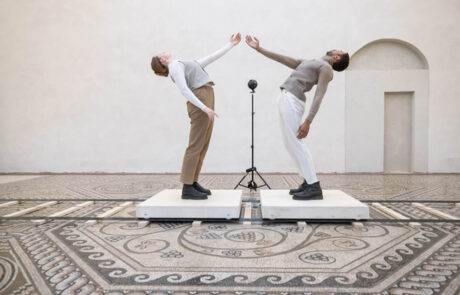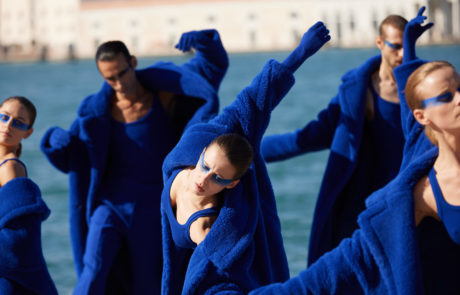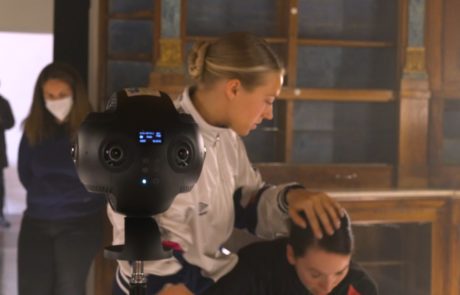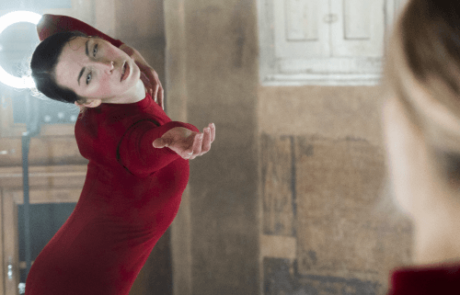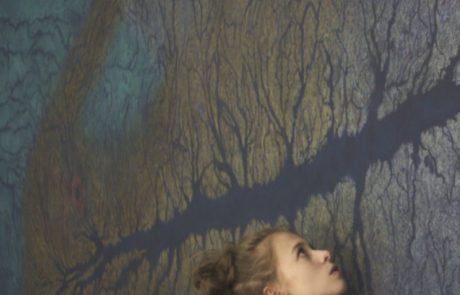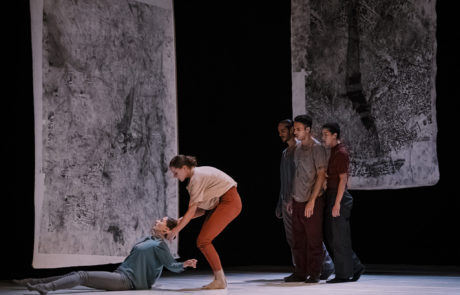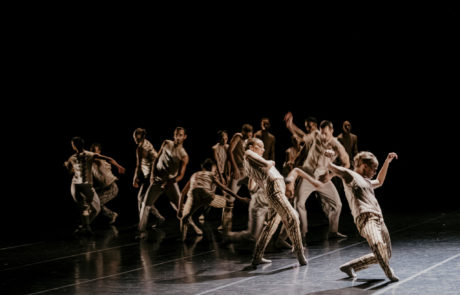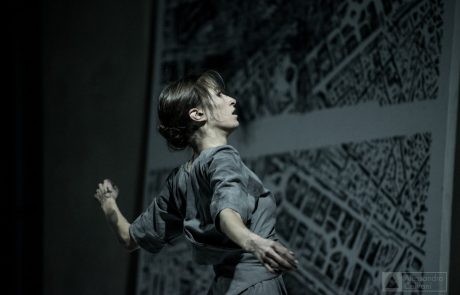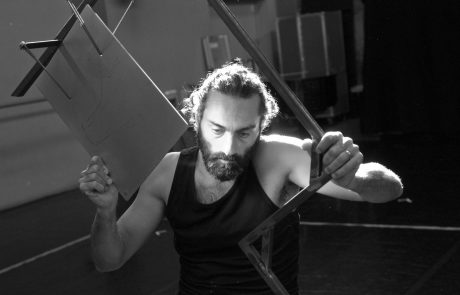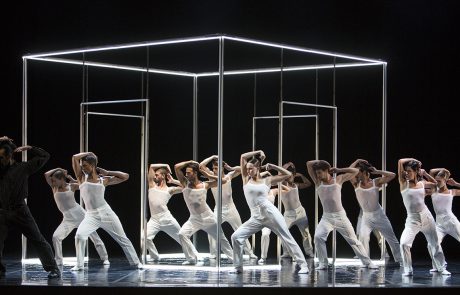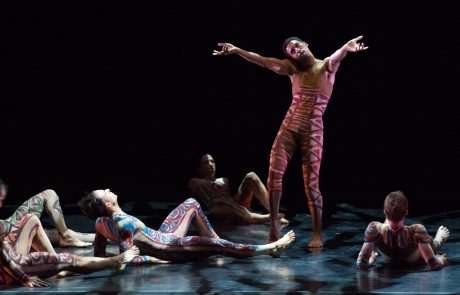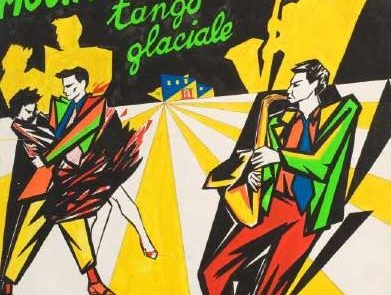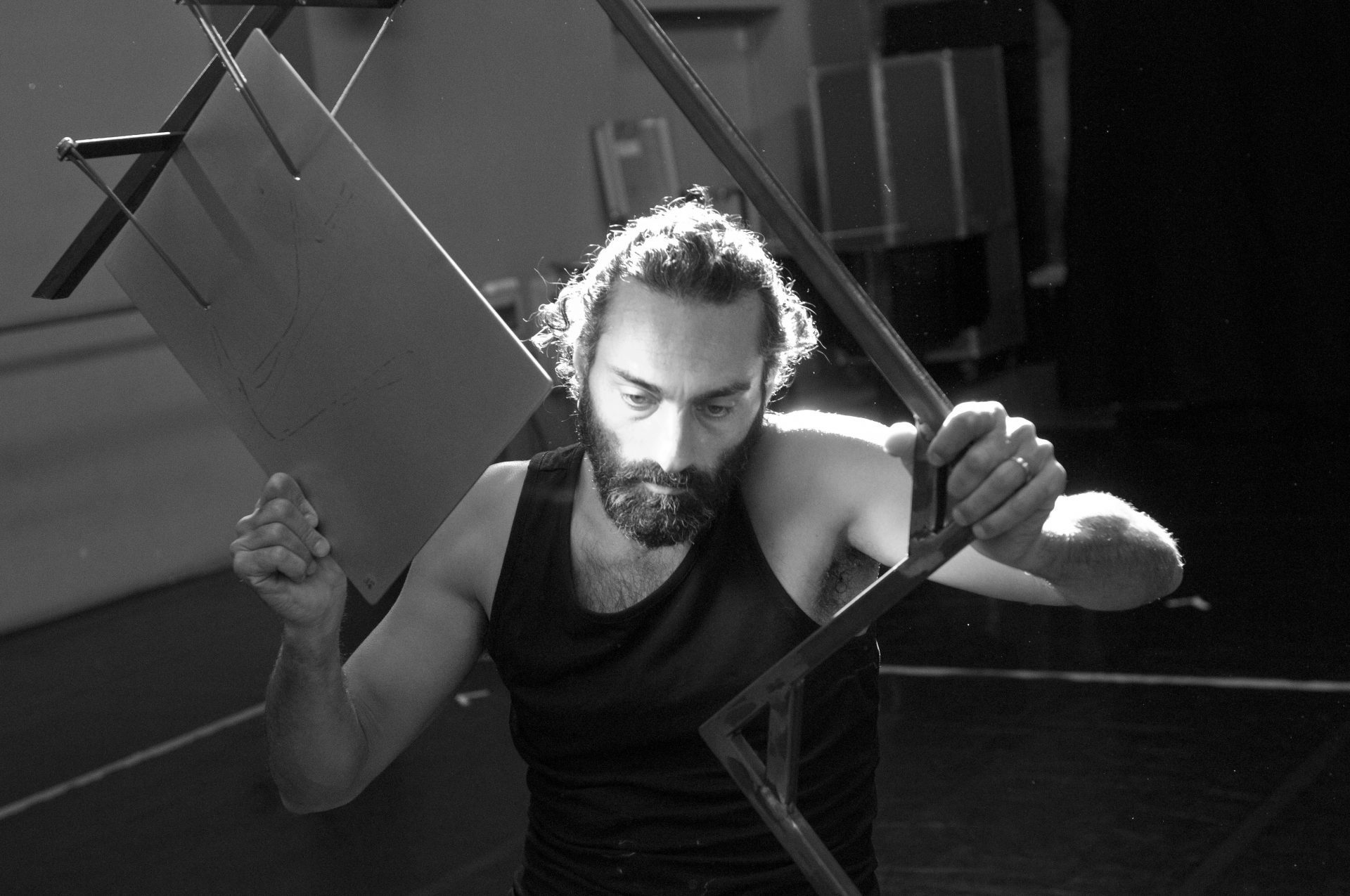Nine Bells is a performance for one dancer-choreographer, one percussionist, nine bells and one light designer, inspired by the work under the same name by composer Tom Johnson. It originated from Valerio Longo’s encounter with the music of percussionist Simone Beneventi, the winner of the Silver Lion for music at the 2010 Biennale di Venezia.
Nine Bells explores the multiple combinations of 9 bells suspended from a 3×3 grid, where the bells are about 2 metres apart from each other. The music is produced by the toll of the bells according to precise routes around the installation. The piece stimulates walking, a lot of walking, slow or fast, and the noise the steps make is an integral part of the work. All the possible routes are systematically explored, since the percussionist hits each bell upon its passage. As a result, all the possible melodies are produced, as well. The performance is a challenging physical exercise for the performer and has a great visual impact on the audience. Like in many of his works, theory and practice meld into one, but it is not abstract at all. The structure of the piece can be seen and felt at the same time.
The support of the Fondazione Nazionale della Danza stands as proof of its central interest in the relationship between music and dance, in addition to being a sign of respect and recognition for a longtime dancer of the company who is beginning an independent creative career.
We approached this work moved by curiosity and fascination towards a work that, by its compositional nature, brings with it an evident performative character.
The idea of playing to insert ourselves in that structure, of supporting and contrasting it, of ignoring and increasing it, immediately attracted us but, after the first listenings we began to realize, above all, the power of the compositional organization, of the stubborn search for a spatialization that links the movement of the performer to the construction of the vertical sound, in short, we were in front of a monolith, solid, powerful, impending and, suddenly, here it is, strong and dazzling, the idea to face and play with that piece. The Monolith!
Tom Johnson’s Nine Bells, played by Simone Beneventi, would have been the great, immanent law that governs nature and, Valerio Longo the man, a simple element of that nature, who leads his life on the path established by those laws but that, and here we begin to unworthily bother the older ones, amazed by the wonder and troubled by terror begins his path of knowledge.
It is certainly not our intention to translate a part of the history of human thought into performance, we have used the movement to tell, in the way we know it, the road to intimate and personal maturity, we have freed the need to tell a small story that, like all small sincere stories, contains universal elements.
Carlo Cerri
How did you imagine the structure of the show and what are you going to tell?
I thought about evolutionary steps, starting from the birth not necessarily of the living being but also of a thought, of an emotional state, of a form of life, of a mathematical process. The beginning is an awakening from a primordial stage, physical, cultural. It is of the man still without norms, unaware of having already in himself all his laws. He only has to discover them. The story is precisely this: the inner search for awareness and knowledge. This first phase, after reaching an upright position, is lived out of the space of the bells. There is therefore an attempt to fit between the nine gears. In there, however, she still doesn’t know how to move. It is attracted by the sound, by the movements of the musician, but that path must remain free, and occupying it is undermined. Understanding the rules he tries to impose his own by interacting with the structure and moving the position of the bells. By putting order he enters, plays and dances in a state of liberation of the body. The musician is still, he observes him. There is a sort of “step by step” with an imaginary figure. It is knowledge with the other half of oneself, with the irrational, feminine part, difficult to manage emotionally. Despair takes over. It falls, collapses, gets up, runs between the plates. It is the moment when sound produces a circular sense. Thought of as a game, the two performers run together, then detach themselves, and each performs its own performance. The costume of the dancer is also important: it’s like a second skin, says his nature as a hunter, a warrior, a man who is on the way to knowledge, who imposes laws, who dominates. The costume tells the different narrative passages.
Finally, we come to the starry sense, as in the Kantian revelation: “the starry sky above me, and the moral law in me”.
It was one of our creative references, perhaps the red thread of all our work. Continuing in the description, the dancer, now inside the structure, plays with the musician. Convinced he can manage it, he precedes it, follows it, anticipates it again in his movements, and finally stops it. He enters in reverse order, interrupts the plates, blocking them in the resonance. If we want to enucleate the various moments of the performance, we can synthesize it in passages from an embryonic and primordial stage, to a human one; from animal-like to wild; then, from an acquisition of thought, to a discovery of places. Man becomes a traveler who experiences different alchemies, becomes the master of the place, and changes it. His is a constant mutation. Even the vibrations of the bells, even with the same note, are never the same, because the musician who imprints that touch on the single plate will always do it in a different way, and therefore I too experience a mutation. Nine Bells is discovering the cyclicality of the human being, who renews himself. The sign 9 is an unclosed, ascending infinity. When I close the last sound of the bell I don’t know where I will go, what will happen next. It is the last vertex of the star drawn by Johnson.
What would you recommend to the spectator who is about to see the show?
A piece of advice I could give when I enter the place that welcomes it is not to think of it as a show, but to try to live it as an experience; to create an empathy with what it feels and sees, as much as possible free of expectations. As when you are interested in a book, you open it, you start to read, but you don’t know what the story will reveal.
Giuseppe Distefano
Nine Bells (1979) is a key work in Tom Johnson’s production, it goes beyond the mathematical approach and generative development, typical of his music, to border on performance itself, on the figurative use of space and on the architecture of sound bodies. It is a synthesis between creativity (it is still a musical composition rich in tensions, ideas and invention) and discipline towards schemes and calculations that govern both the musical material and the movements of the performer. Nine Bells explores the multiple combinations of 9 bells suspended in a 3 × 3 grid, where each bell is located about 2 meters away from the others. Divided into nine movements, each one begins with the sound of a different bell and is completed by showing the whole process of elaboration of an initial formula, thus creating geometric paths from the figures that are different each time.
The work was born not as a composition written to be played by others, but as a performance performed by Johnson himself.
It was born as his performance, but given the considerable physical effort (the work lasts about 50 minutes in which you run or walk non-stop), ahead of the age Johnson decided to transcribe on the score all the instructions, to allow other performers to realize it later. At that moment the score was born, written in traditional form (notes on pentagram, with batting divisions, durations, pauses, dynamics etc.) and where the indications of metronome refer not only to the speed of the music, but also to the speed of the steps, sometimes specifying also with which foot to start. The score is completed by the drawings of the nine paths between the bells, generated by each scene, which are very useful for the memory of the performer. The preface also indicates the intonation and the exact position where to place the nine instruments on stage. The choice of the type of bell is left to the discretion of the interpreter. Among the very few who have so far ventured with this score (perhaps about ten in the world), there are those who have preferred to use tubular bells, or church bells, ceramic or terracotta. We have chosen brass plate bells with a rectangular shape. The first bells Johnson used were the red caps of the mechanical hammer bells that rang in the corridors of American colleges. He had therefore chosen nine of them, corresponding in intonation to as many notes (in reality eight, being a note repeated twice), and then suspended them with wires, lowering them directly from the ceiling and then playing them manually, with a knocker. To do this it is therefore necessary to move through space according to different speeds and trajectories for each of the nine movements. It is clear that such a work cannot be made by reading the score, walking along the stage for 50 minutes carrying a score: it must be performed by heart.
So from a formal point of view, and in terms of timing, it is precisely the mathematical game that governs the whole system.
One of the dominant compositional techniques in the work is the rigorous one of permutation: starting from a musical sequence, changing or moving an element, a pause, a note, a variation is created, and the score becomes the whole cycle of all possible variations. From this derives the duration of each movement: the scene, like an inexorable gear, stops only after having completed its entire evolution. The procedure is so explicit that it is immediately evident even when observing the score from a graphic point of view (even before reading and interpreting its values), in the symmetries and sequentiality of notes and pauses; and the same applies to the movements of the performer in space: continuous variations of a single generating figure. An interesting and peculiar aspect is that of the double sound and time plan, rich in meaning. The first, which we can call “subjective time”, is given by the sound emitted by the bells, with a rhythm that is sometimes more intense and tighter, others more relaxed and calm, and that in any case depends on the strength, expressiveness and energy of the performer’s gesture. The second, “objective time”, is given by the noise of the steps, which is not at all a residual noise, disturbing, but strongly structural. It is Time with a capital T, which flows inexorably and made audible by the steps, like the ticking of a clock: it is the perpetual motion on which the musical discourse of the bells rests. Despite the originality of the project and the extreme rigor, which seems to cancel the humanity and expressiveness belonging to the music to which we are most accustomed (singing in the first place), in a sense Nine Bells is still a classical composition: they alternate, as in a symphony, fast movements, slow, cheerful, adagio, jokes, major and minor tonalities, ternary and binary times, marches, games counterpointists etc …
The performative aspect is essential because you can not perform the score unless you do exactly certain movements and steps. How did you work with Valerio and Carlo Cerri to tune music and dance, mathematics and improvisation?
Being a defined score, which absolutely denies the space to improvisation, we have reflected especially on the characteristics of each movement, and on the overlapping of choreography and music, taking all the few freedoms that the composer grants more or less explicitly, such as the possibility of rethinking the order of the nine movements, and thus create, with the original choreography, a new narrative path. It was useful, in the initial phase, to symbolically identify each of them with an archetypal idea, or a technical and concrete image. For example, one was renamed in the study phase “step by step” because it was played on the alternation of two elements easily identifiable as “masculine and feminine”: very angular, metallic, sharp sounds, and round, soft sounds, in dialogue with each other within the same scheme. When we chose this score, it was clear to all three of us that it was a challenging one. To create on such a rigorous and unitary music (and cumbersome also in terms of space, because of the voluminous installation) a choreography that is not an overlap but something integrated, is more complex than to work on a music articulated according to the choreographic needs: improvised or written, recorded or performed live, pre-existing or created ex-novo. It was therefore fundamental to find a key for each of these movements and to allow access to Valerio both as a choreographer and as a performer. But, each of the nine movements having such a strong and different identity and soul, what seemed too ambitious a challenge proved to be a precious opportunity to bring into play the mutual sensibilities.
Are there moments of interaction?
Sometimes Valerio enters the installation and plays, moves with me, guided by the time of my steps. It is a pulsation to which everything is connected, even in the freest and most informal parts where the time of the movements of the dancer is completely free from the rigorous structure.
What can such a seemingly cold score emotionally arouse for the spectator? What advice would you give to enter into the vision and listening of Nine Bells?
Performing arts today have to deal with a capacity and aptitude for reception and concentration that are certainly more limited than in the past. Nine Bells is a challenge. A 50-minute work, with few elements, but within which there is a subtle alternation, asks the audience also a bit of effort: not to stop at the impact given by the first movement, the first bars, the first steps, but to open up to a new sound universe and an original and authentic performance. Once you get into this very reverberant and enveloping sound, the ear gets used to it, the eye begins to catch the performer’s movements, to recognize his geometries, and, why not, to enjoy a mathematical game and form, which has its own beauty. The most suitable situation, but impossible to achieve, would be to have the viewer inside the grid of bells. With a traditional arrangement of the audience in the stalls, it is not given to them to live the immersive experience within this vibrant space that instead Valerio and I experience: moving between these sources, 9 distinct sound sources, in a continuous variation of closeness and distance, the listening is very iridescent and naturally different from the frontal one where all the sounds are mixed and arrive, more or less distinctly, to the audience. The ideal fruition, already practiced and suggested also by Johnson, would be to have the whole audience around the bells: a closeness that increases the value of the experience. Another resource that would help the audience to get even more in touch with the work would be to visualize from above the geometric movements of the paths, for example by filling the ground with sand, so that, along with the sound trail of resonance, there is also the trace of the steps, which gradually draw circles, ellipses, stars, diagonals.
This does not mean that the listening required is not demanding…
Yes and no. On the one hand it is a very simple and linear music, which renounces the complexity of classical music, usually full of information that stratify creating a musical architecture both vertical (harmonic) and horizontal (melodic), made with sometimes complex means such as the symphony orchestra or more simply, but no less intensely, with few chamber instruments. Certainly a known theme is much more gratifying, easier to listen to. Here it is different. They are few notes, they are formulas, and I think it can be very satisfying for the spectator to be able to understand how it works, because in its simplicity it allows itself to be read, understood, listened to even in the most structural elements. This, on the other hand, is much more complex as far as classical music is concerned, where analytical listening is a matter for the few. On the contrary, I believe that after a while, entering into the game, simple formulas become so intuitable that the public, recognizing them, can almost anticipate the solution, the sequel. All this certainly does not replace the emotional experience of spontaneous listening, which even here, however, does not fail. It is up to the performers to keep alive the central importance of communication with the public in their research: this is the challenge of Nine Bells.
Giuseppe Distefano
Next dates
Choreography
Valerio Longo
Direction set and costume design
Valerio Longo and Carlo Cerri
Music
Nine Bells by Tom Johnson
Performed live Simone Beneventi
Lighting design
Carlo Cerri
Critical consultant
Giuseppe Distefano
Performers
Valerio Longo and Simone Beneventi
Production
Fondazione Nazionale della Danza / Aterballetto
In partnership with Associazione La Sfera Danza
Duration 50’
Preview
october 6th 2018, Teatro Verdi, Padova
World premieres
October 10th 2018, Fonderia, Reggio Emilia
October 13th 2018, Teatro Franco Parenti, Milano
